 Image search results - "shiba" Image search results - "shiba" |

Entrance to Kyu-Shiba Rikyu Gardens, a real oasis in an urban jungle. Another waterfront garden with classic Japanese-style elements with a pond, pine trees, rocks, and stone lanterns.
|
|

Seibu Ikebukuro Line train station entrance at Ikebukuro, Tokyo. It takes about 90 min. from Ikebukuro to Yokoze Station via Tokkyu express train. Cheaper trains take 2 hours.
|
|

Sando worship path to Taishakuten temple. Shibamata is in Tokyo's Katsushika Ward bordered by the Arakawa River in the west and by the Edogawa River in the east.
|
|

"Watakushi, umare mo sodachi mo Katsushika, Shibamata desu..." (I was born and raised in Shibamata, Katsushika Ward) If this opening line sounds familiar, you must be one of the many ardent fans of Tora-san movies.
|
|

Kyu-Shiba-rikyu was first built in the 17th century and used as the residence of a number of nobles. Purchased from the Arisugawa family in 1875 by the Imperial Household Agency which made it the Shiba Detached Palace.
|
|

Seibu Ikebukuro Line train with shibazakura design.
|
|

The Tora-san "Otoko wa Tsurai Yo" (It's Tough Being a Man) movie series was played by the late Atsumi Kiyoshi. Tora-san is Japan's most lovable drifter and lovelorn on the silver screen. Forty-eight movies in this series were produced from 1969 to 1995. Katsushika-ku is where the Tora-san Museum is.
|
|
|

Bird's eye view of Kyu-Shiba Rikyu Gardens as seen from Hamamatsu World Trade Center
|
|

Seibu Ikebukuro Line Yokoze Station. Get off here for an easy walk to Hitsujiyama Park where the Shibazakura moss pink hill is. A tourist info office is on the left. 西武池袋線横瀬駅
|
|

Statue of Tora-san in front of Shibamata Station. Posed like he's going to the station for another faraway trip...
|
|

Sando worship path to Taishakuten temple
|
|

The buildings were destroyed in the Kanto Earthquake in 1923 and the property was donated to Tokyo in 1924 to commemorate the start of Emperor Showa's reign.
|
|

You can buy a park entry ticket (300 yen) at a booth in front of Yokoze Station. Maps also available. Underpass at Yokoze Station.
|
|

This is a pose when Tora-san goes to the Shibamata Station and he looks back to his sister Sakura who calls him.
|
|

The path is lined with shops.
|
|
|
|

The first Tora-san movie came out in 1969 and over 40 more installments have been produced since then. It is entered in the Guiness Book of World Records as being the movie series with the most sequels.
|
|

Tora-ya
|
|
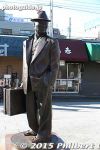
He will soon be accompanied by a statue of his sister Sakura.
|
|

Pine trees and pond
|
|

Entrance to Hitsujiyama Park. Show your ticket or buy it at the booth nearby.
|
|

Shibamata Station is on Keisei Kanamachi Line which runs between Kanamachi Station on the Japan Railways Joban Line (originating at Ueno Station) and Keisei Takasago Station on the Keisei Main Line coming from Keisei Ueno Station.
|
|

This is the shopping arcade which serves as the setting for the famous Tora-san movie series starring Atsumi Kiyoshi.
|
|
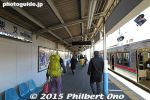
Shibamata Station platform
|
|
|

If you go early in the morning, there are fewer people.
|
|

Shibamata Station platform
|
|

When you get to Shibamata, don't expect the quiet shitamachi charm depicted in the Tora-san movies. Expect a lot of tourists instead, especially on weekends and holidays.
|
|
|

Quite spectacular when the flowers are in full bloom.
|
|

Shibamata Station
|
|

Fame has brought prosperity to the shops which line the mall leading to the Shibamata Taishakuten Temple. This shop, called Kameya Honpo, apparently served as the model for the Tora-ya dumpling shop.
|
|
|
|
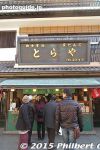
Shop called Toraya.
|
|
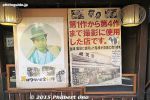
This shop was used in the early Tora-san films.
|
|
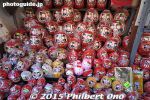
Daruma dolls
|
|
|

These photos were taken in late April 2007. (Copyright year in the images are mistaken.)
|
|

There are plans to build a statue of Sakura, Tora-san's sister, near this statue at Shibamata Station
|
|

The shop sells kusa dango (mugwort dumplings with real grass inside), the local specialty. Photo: Nitenmon Gate in view
|
|
|

It is not yet full bloom. A few patches of green.
|
|

Toward the end of the shop-lined mall, you will see this Nitenmon Gate of the Shibamata Taishakuten Temple, formally known as Daikyoji. 二天門
|
|

The plot is basically the same for each installment: middle-aged Kuruma Torajiro^ (Tora-san) meets pretty woman (the movie's leading lady whom the Japanese call the "madonna"), has a good time with her and falls in love. Photo: Tora-san Mus
|
|
|

On sunny days, great for taking pictures.
|
|

Wood carvings on Nitenmon Gate
|
|

He somehow always loses her much to the dismay of his married sister Sakura (played by Baisho Chieko) and adoptive uncle and aunt who run a small kusa dango (mugwort dumpling) shop in Shibamata.Photo: Tora-san Museum 寅さん記念館
|
|

Koi carp fish
|
|
|

This temple serves as a recurrent backdrop in the Tora-san series. The temple's priest is played by the humorous Ryu Chishu who actually came from a family of Buddhist priests. Photo: Bell tower
|
|

He is a drifter who travels extensively all over Japan and works as street vendor/hawker selling little trinkets and what not. Photo: The stripe pattern of the walls is the same as Tora-san's coat.
|
|

Bracing a pine tree for winter snow.
|
|

Eight varieties of moss pink are planted. This is Autumn Rose. オータムローズ
|
|

The Nitenmon Gate was completed in 1896 and features wooden statues of Zocho and Komoku, two of the four Devas which guard the four cardinal directions from demons.
|
|

He returns home to Shibamata every once in a while, usually at a most inopportune time for the family, and eventually leaves in disgrace after a family argument or lost love. Photo: Map of Japan marking all the prefectures where Tora-san was filmed.
|
|
|

Autumn Rose. Moss pink flowers have five petals with notches, looking like miniature cherry blossoms. The flowers are small. オータムローズ
|
|

Founded in 1629 by a priest named Nitchu and his disciple Nichiei, the temple belongs to the Nichiren sect of Buddhism.
|
|

It is difficult to pinpoint exactly why the series is so popular and enduring. It's probably a combination of several elements. Photo: Summary of all movie installments
|
|
|

Moss pink is therefore commonly called "shiba-zakura" which can be translated as "grassy cherry blossoms" or "lawn cherry blossoms."
|
|

The present Naiden (Inner Sanctuary) was completed in 1915. Keyaki (zelkova) was used for all the wood in the building. The present Haiden (Worship Hall) was completed in 1929. Photo: Taishaku-do Hall 帝釈堂
|
|

The hilarious humor of the characters, the heartwarming scenes, the shitamachi charm of Shibamata, the beautiful scenery and quaintness of the places Tora-san visits, the guest stars. Map of Japan marking all the prefectures where Tora-san was filmed.
|
|

Yukimi Stone Lantern
|
|
|

Taishakuten is the god Indra from Brahmanism, a Hindu religion. Being the god of rain and thunder, Indra was a powerful warrior god that was adopted by Buddhism as a protector. Photo: Glass wall protecting the exterior of Taishaku-do Hall.
|
|

Atsumi Kiyoshi who seems to have been born to play Tora-san. (Atsumi never seemed to age even after over 20 years in the role. Tora-san's carefree, happy-go-lucky lifestyle also appeals to many. Photo: Sculpture of Tora-san's famous hat and bag.
|
|
|

Little Dot. リットルドット
|
|

It was believed that Indra would step in and chase away the demons causing calamities to the followers of Buddhism. Photo: Wood Carving Gallery (admission charged)
|
|

Sculpture of Tora-san's famous hat and bag
|
|
|

Little Dot are white flowers with a yellow dot at the center. リットルドット
|
|

The side and rear exterior walls of the Taishakudo are blanketed with panels of detailed woodcarvings. They are the most outstanding feature of Shibamata Taishakuten Temple.. 彫刻ギャラリー
|
|

Notice the figure on the upper right...
|
|

Dry waterfall
|
|

Little Dot
|
|

There are ten large carvings (each 2.27 meters by 1.27 meters) depicting scenes from the Lotus Sutra (Hokekyo).
|
|

Entrance to Tora-san Museum where Tora-san is helping to install the museum sign.
|
|

Stone monuments
|
|
|

The woodcarvings were requested by the temple's 16th priest, Nissai. Through a generous donation from devoted follower Suzuki Genjiro, the project was begun.
|
|

Tora-san is helping to install the museum sign.
|
|

McDaniel's Cushion マックダニエルクッション
|
|

The first panel was completed in 1922. The carver, Kato^ Toranosuke, proposed that the remaining 9 panels be carved by renown woodcarvers living in Tokyo. A large keyaki panel was delivered to each of the nine carvers.
|
|

Tora-san is helping to install the museum sign. What a great gag. Get you laughing even before you enter.
|
|

Bridge to Nakashima island
|
|

McDaniel's Cushion are dark pink flowers. マックダニエルクッション
|
|

However, in 1923, the Great Kanto Earthquake struck and these panels did not survive. A subsequent search for replacement panels was conducted nationwide.
|
|
|
|

Nakashima island
|
|

McDaniel's Cushion
|
|

In 1926, large keyaki replacement panels were finally procured and the project was back on track. The carvings were completed in 1934.
|
|
|
|
|
|

Since such large pieces of keyaki wood are very difficult to find and the carvings are so fine, the carvings are regarded as highly valuable cultural assets.
|
|

Actual film studio mockup of Kuruma-ya dumpling shop
|
|
|

Oakington Blue オーキントンブルー
|
|

If you want a detailed explanation (in Japanese) of the Lotus Sutra scenes depicted by the woodcarvings, buy the pamphlet that is sold at the temple's souvenir stand near the Nitenmon Gate.
|
|

葛飾 柴又 くるまや
|
|
|

Oakington Blue are bluish flowers. オーキントンブルー
|
|
|

Inside the studio set of Tora-san. Reconstructed with the original studio set materials used at the Ofuna movie studio.
|
|
|

Oakington Blue
|
|
|

Kuruma-ya dumpling shop
|
|

World Trade Center in Hamamatsucho overlooked the garden. World Trade Center Building (世界貿易センタービル) in Hamamatsuchō was a 40-story commercial skyscraper. It was once Japan's tallest building in 1970.The building closed for good on June 30, 2021 and was torn down during Aug. 2021 to March 2023. The building will be replaced with a new World Trade Center building to be completed in March 2027.
|
|
|
|

Family living room
|
|

Scarlet Flame スカーレットフレーム
|
|
|

Family living room
|
|

Scarlet Flame are red. スカーレットフレーム
|
|
|

Inside the shop
|
|

Scarlet Flame
|
|

To protect the exterior woodcarvings from the elements and to allow visitors to view them up close, the temple built a transparent, permanent scaffolding on the side and rear exterior walls of the Taishakudo.
|
|
|
|

It makes you feel like you are in an art gallery. From the front of the Taishakudo, the scaffolding is neatly concealed from view.
|
|
|
|

Tama-no-Nagare. Means "Flow of Tama." Tama is a river. 多摩の流れ
|
|
|

Kitchen where they made the dumplings.
|
|

Tama-no-Nagare have a pink stripe on each petal. 多摩の流れ
|
|
|
|

Tama-no-Nagare look light pink from afar.
|
|
|
|

Miniature shop arcade
|
|
|
|
|
|

The top of one slope provides a grand view of the flower carpet and Mt. Bukosan, one symbol of Chichibu. 武甲山
|
|
|

Tora-san's documents
|
|
|
|
|

Tora-san's passport
|
|

Mt. Bukosan is being slowly eaten away by cement companies. 武甲山
|
|
|
|

Tora-san's personal effects
|
|
|
|

Contents of his famous travel bag
|
|

武甲山
|
|
|

Tora-san haniwa
|
|
|
|
|

More exhibits
|
|
|
|
|
|

武甲山
|
|

Since the carved walls are two stories high, the scaffolding has upper and lower levels which allows you to view the woodcarvings on the upper and lower halves of the walls. This is the lower floor
|
|

Movie posters
|
|

Benches offer visitors a rest.
|
|

Dragon
|
|

Movie posters
|
|
|
|

You can walk down a corridor to the Daikyakuden (Reception Hall) made entirely of hinoki (Japanese cypress). This hall faces the lovely Suikeien Garden.
|
|

Leading ladies or the "madonna." It's quite an honor for an actress to be chosen as a madonna in a Tora-san movie
|
|
|

Corridor to Guest House (Dai-kyakuden)
|
|

Tora-san souvenir shop
|
|
|

Even the corridor has wood carvings.
|
|

After visiting the temple, most of the tourists walk to the nearby Edogawa riverbank which you often see in the Tora-san series. Road to Yagiri no Watashi (boat crossing)
|
|

I found an almost infinite number of image combinations of the flowers and mountain.
|
|

Corridor of guest house 大客殿
|
|

Edogawa River. Visiting Shibamata will enable you to appreciate and understand the local settings used to film the Tora-san series.
|
|

Mt. Bukosan and moss pink. 武甲山
|
|

Hina dolls in guest house room 大客殿
|
|

Many movie scenes were filmed along this riverbank.
|
|
|

Hina dolls in guest house room 大客殿
|
|

To Yagiri no Watashi
|
|
|

Hinamatsuri dolls 大客殿
|
|
|
|
|

Folding screens
|
|

The boats operate on weekends. Fare is 100 yen one way.
|
|

The combination of Mt. Bukosan and the flowers are almost unlimited. Chichibu, Saitama. 武甲山
|
|
|

Yagiri no Watashi boat dock
|
|
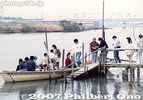
This form of public transportation dates back to the Edo Period when there were 14 locations in Tokyo where such boats operated. Only this one now remains. Boarding the Yagiri Watashi boat. 矢切の渡し
|
|
|
|
|

Yagiri no Watashi boat crossing. After the two-minute river crossing, you will be in Matsudo, Chiba Prefecture. You can then tour various temples and parks in Matsudo and neighboring Ichikawa on foot. There are signs along the way to guide you.
|
|
|

Garden hallway 庭園
|
|
|

Tea ceremony house 茶室
|
|
|

Suikeien Garden 庭園
|
|
|
|
|

Nitenmon Gate as seen from Taishaku-do Hall
|
|
|
|
|
|
|
|
|
|

Rear of Nitenmon Gate
|
|
|

Nitenmon Gate carvings
|
|
|

Nitenmon Gate carvings
|
|

Are your eyes getting tired of seeing this mountain and flowers?
|
|

Daishoro (bell tower)
|
|

Tulip and moss pink
|
|
|
|

Tricot
|
|

Goshinsui (purification water fountain).
|
|

Y
|
|

Goshinsui (purification water fountain).
|
|

Y
|
|

Sacred water 御神水
|
|

The flower patterns don't look like anything.
|
|

Minami Daimon Gate 南大門
|
|
|

Hondo Hall and Shaka-do Hall
|
|
|

Hondo main hall 本堂
|
|
|

Map of temple grounds
|
|

The park allows dogs, but they bark and ruin the peace. They should ban dogs from the park.
|
|

Corner work
|
|
|
|
|
|
|
|
|
|
|
|
|
|

The shadowy areas bloom much later.
|
|
|
|